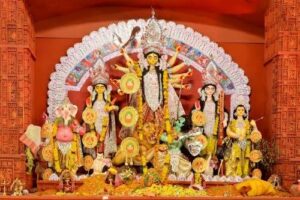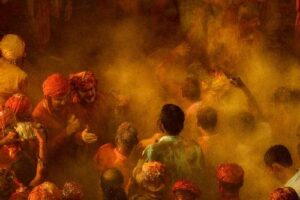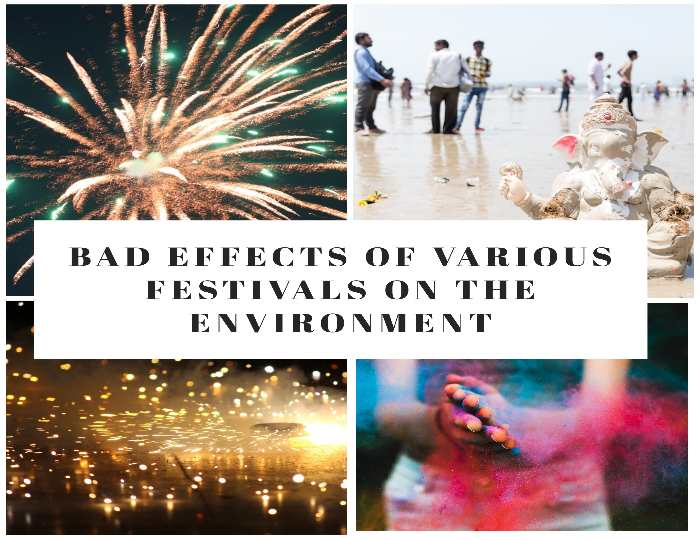Owing to the diverse cultures, ethnic backgrounds, languages, religious sentiments, history and different traditions in its states, India is also known as the land of festivals. In this article we shall discuss about the bad effects of various festivals on the environment.
There are about 20-30 varied festivals celebrated in each state and almost every week is marked by an important festival that the country celebrates in unison. People celebrate festivals to get away from their monotonous lifestyle and have fun and delicious food together with their friends and family. But there are also some bad effects of various festivals on the environment. It mainly includes the pollution they often lead to in all spheres of environment mainly air, water, soil, noise.
Owing to different studies, the researchers have assessed the awareness level about ecological pollution caused during the festivities. They have also successfully explored the social work intervention to spread awareness regarding the celebration of festivities without causing any ecology harm. Descriptive research design was adopted for the study of bad effects of various festivals on the environment.
The non probability sampling method was used with a purposeful sample technique. 50 samples were taken in total for this study. The study found that the low awareness about ecological protection among people is the leading cause for pollution in the name of festivities.
The researchers then came up with a Social Work intervention for bringing awareness among the locals regarding environment protection. Simple percentile and central tendency methods were used for statistical analysis and SPSS 20 for computing data.
The bad effects of various festivals on the environment
Here are a few examples of how festivals lead to adverse effects on the environment.
1.DIWALI
Unfortunately, every year, the quantum of air and noise pollution caused due to the bursting of firecrackers on Diwali keeps on increasing.
The firecrackers release pollutants like sulphur dioxide, carbon dioxide, carbon monoxide etc in the air which leads to ailments such as asthma and bronchitis.
Not only the humans but the animals and birds are also affected due to this level of pollution. Various schools and organisations organise demonstrations prior to Diwali to educate the masses on a pollution-free festival but their efforts continue to be futile. The pollution caused on Diwali is thus among the bad effects of various festivals on the environment.

The suspended particles in the air increases alarmingly during Diwali that leads to eye, respiratory, and hypersensitivity (allergic) problems. The same goes for the after effects of air pollution caused during Dussehra. These problems often develop later in people’s life and are not felt immediately. An increase of around 30%–40% in the cases of wheezing, exacerbation of bronchial asthma and other respiratory diseases are reported during the Diwali festival each year.
The environment department has been trying to control this by publication of notices in various newspapers regarding the regulations to curb the pollution level on Diwali but to no avail.
As per directions of the Supreme Court the bursting of sound-emitting firecrackers has been banned between 10pm to 6am but shockingly, the directions are often openly flouted as firecrackers are bursted throughout the night. This causes excessive noise and air pollution. On the receiving end of this menace are mostly the elderly and patients that often end up in hospitals.
Post Diwali, the roads are always found to be littered with the remnants of fireworks and deluge of garbage including empty bottles used for lighting off rockets on every corner of the city which is a worrying signal.
2. GANESH CHATURTHI
A large population in India is still unaware about the pollution caused by the Plaster of Paris (POP) made Ganesh idols and the chemical paints used in them. The pollution caused on Ganesh Chaturthi is among the bad effects of various festivals on the environment.
*POP is not a naturally occurring material and it contains gypsum, sulphur, phosphorus and magnesium. The idols take several months to dissolve in water and in the process poison the water bodies that leads to water pollution.
* The chemical paints used for decorating the Ganesh idol contains mercury, lead and other harmful materials that increases the acidity and heavy metal content of the water when the idol is immersed in it.
*The careless dumping of accessories used during this festival like thermocole, plastic flowers, cloth, incense etc in water further adds more strain to the already polluted rivers and lakes.
* Careless dumping of POP made Ganesh idols in water bodies blocks the natural flow of water and results in stagnation and breeding of mosquitoes and other pests.
* The pollution from Ganesh Chaturthi idols also damages the ecosystem and harms marine lives.
The after effects mentioned above can thus be included in the category of bad effects of various festivals on the environment.
3. DURGA PUJA

Durga puja is the festival that Bengalis feel pride in being part of the community. The religious significance of immersion of Goddess Durga at the end of the festivity represents her safe return to her husband Lord Shiva.
The pollution caused during this festival is also among the bad effects of various festivals on the environment. In the opinion of Niyati Seth, a Research Associate at The Energy and Resources Institute: “Idols are mostly made of PoP and decorated with non-biodegradable materials (plastics, thermocols, etc.) which are highly contaminating in nature”. To counter this, the government has now started encouraging use of clay and other natural materials suggested by the holy scripts for making idols.
The loud music played during the immersion of Goddess Durga in procession further adds to sound pollution in the environment. The music is soothing only upto a certain decibel. So the music must be played at a soothing level to avoid causing sound pollution.
But despite suggested measures for reducing pollution caused in Durga Puja, many people still continue breaking all rules that leaves an adverse effect on the environment.
4. HOLI
Also known as the Indian “festival of spring”, the “festival of colours”, or the “festival of love”, this festival signifies the victory of good over evil. The night before Holi, bonfires are lit in a ceremony known as Holika Dahan (burning of Holika) or Choti Holi. People gather near fires, sing and merrily dance.
Such a colourful Holi has now been overtaken by commercialisation, which has started providing exotic colours in a highly dangerous form. The colours used to play Holi are often made of toxic chemicals. The use of such colours cause irritation to the skin and can sometimes trigger some allergy or skin disease. Moreover, they do not wash away easily, get mixed in drains and sewage systems, and pollute water bodies and the soil.
These after-effects mentioned above are the leading cause of the categorization of the after-effects of Holi in the domain of bad effects of various festivals on the environment. The festival which was once a healthy revelry of mankind is no longer an exuberant and healthy event.
Measures that were taken by the government to control the bad effects of various festivals on the environment
After attaining independence from Britain, India adopted a constitution in 1950 and numerous British-enacted laws without any specific constitutional provisions on protecting the environment.
Article 48(A) of Part IV of the amended constitution states that- The State shall endeavour to protect and improve the environment and to safeguard the forests and wildlife of the country. Article 51 A(g) further imposes additional environmental mandates on the Indian state that it has to oblige with.
Some of the steps taken by states for reducing the bad effects of various festivals on the environment are discussed below-
1.Judgement of the Supreme Court of India regarding the use of firecrackers during Diwali, 09/10/2017
The judgment of the Supreme Court of India in the matter of Arjun Gopal & Others Vs Union of India & Others dated 09/10/2017 was regarding the extensive use of fireworks (including the use of firecrackers during Diwali).
The Applicant pointed out that the onset of winter itself deteriorates air quality in Delhi NCR and it gets aggravated because of the bad effects of various festivals on the environment and the marriage seasons that occur during these very months. Taking note of the aforesaid factors, particularly the impact of fireworks on the ambient air and unhealthy effects thereof which had created an unprecedented situation in Delhi, with air pollution going up at alarming levels, it made it the most polluted city in the world.
A ban was put on the sale of firecrackers in Delhi and NCR by the Supreme Court. Further orders in this behalf were decided to be passed after assessing the situation that would emerge after the 2017 Diwali season. This was indeed a great step taken by the state government for countering the bad effects of various festivals on the environment.
2. Ganesh idol immersion & water pollution in the state of Maharashtra: an action plan

The state of Maharashtra is soon to proceed with an action plan to reduce the amount of water pollution caused during God Ganesh idol’s immersion at Ganesh Chaturthi ( that comes under the category of bad effects of various festivals on the environment).
Way forward: what can be done
In view of the above mentioned bad effects of festivals on the environment and public health, the following reasonable restrictions can be taken by the government.
• Imported crackers which are the center of criticism, for example, the Chinese crackers, should be banned by the government. This step will even lead to the use of safecrackers by the citizens and lead to the generation of more employment opportunities.
Strict regulations should be enforced against the domestic products used during festivals to make them environmentally friendly and less polluting to reduce the bad effects of various festivals on the environment.
Further, the mentioning of information regarding the ingredients used in the product like the firecracker and the noise it causes while burning should be made compulsory. This measure will provide greater awareness among people and help in countering the bad effects of various festivals on the environment.
• Information and communication technologies and social media should be used to a greater extent for the societal benefit i.e. for spreading knowledge about the ill effects of high decibel crackers.
• The government should encourage the eco-friendly idols for use during festivals like Ganesh Chaturthi and Durga Puja so that they will not pollute water bodies after immersion.
The government should consider taking the help of educational institutions and even celebrities in spreading awareness in this regard after all the people often tend to emulate the consumption style of other people (which is called demonstration effect).
If the celebrities and other well-knowns use such products and spread awareness regarding the same, people will start using eco-friendly idols as well. This is a great indirect way of countering the bad effects of various festivals on the environment.
• The use of high decibel music beyond a set level should be banned irrespective of the community involved in its use.

•Instead of buying one-time use items, the use of recyclable items should be more encouraged. For example, the government can grant more subsidies to companies producing recyclable products.
•To counter the bad effects of various festivals on the environment, the government must encourage community celebrations instead of special and individual celebrations. This will ensure comparatively less air, noise, and other types of pollution.
These steps will indeed help a lot in reducing the bad effects of various festivals on the environment.
Conclusion
Festivals are undoubtedly among the most important parts of our life. People forget about their past differences and these festivals mark a new beginning for them. Speaking metaphorically, they are a source of love, joy, happiness, and peace in life.
Also read: Festivals of Kerela
But we must never forget our responsibilities as being part of society and always aim at not harming the environment while enjoying festivals. This growing consciousness surrounding our impact on the environment has fortunately led both the industry and individuals to take positive steps to rein in their carbon footprint.
Apart from the need of the hour on part of citizens, the Indian Constitution also seeks to aim for a balance between the fundamental rights of citizens (Freedom of religion from Article 25-28) and the need to secure public order and health by the State.
Article 25 of the constitution provides the freedom of conscience and the right to freely profess, practice, and propagate religion to all the citizens of the country. But the article has a wider aspect than that. It also provides for reasonable restrictions like the practice of religion being subject to public order, morality, and health. So, it is the function of the constitutional bodies and statutory authorities to come up with proactive and on-demand measures to curb pollution caused during the festivals by considering the Article 25 in letter and spirit as well.
After all, conservation is the state of harmony between men and land and we must protect our environment at all costs.

2 thoughts on “Bad effects of various festivals on the environment”